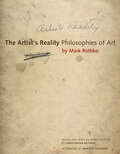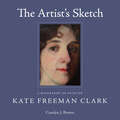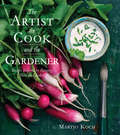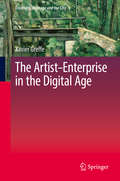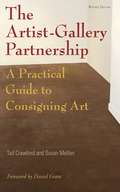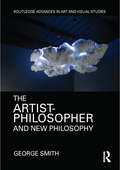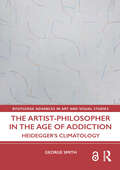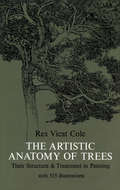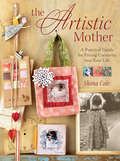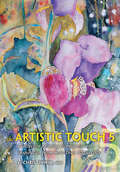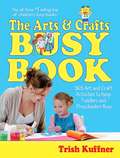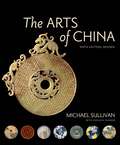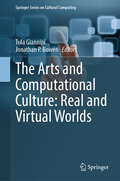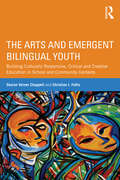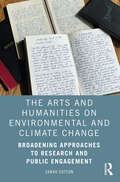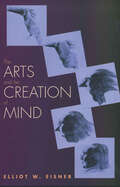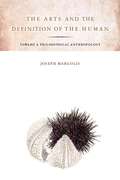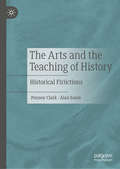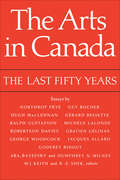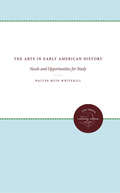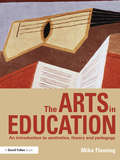- Table View
- List View
The Artist's Reality: Philosophies of Art
by Mark RothkoMark Rothko&’s classic book on artistic practice, ideals, and philosophy, now with an expanded introduction and an afterword by Makoto Fujimura Stored in a New York City warehouse for many years after the artist&’s death, this extraordinary manuscript by Mark Rothko (1903–1970) was published to great acclaim in 2004. Probably written in 1940 or 1941, it contains Rothko&’s ideas on the modern art world, art history, myth, beauty, the challenges of being an artist in society, the true nature of &“American art,&” and much more. In his introduction, illustrated with examples of Rothko&’s work and pages from the manuscript, the artist&’s son, Christopher Rothko, describes the discovery of the manuscript and the fascinating process of its initial publication. This edition includes discussion of Rothko&’s &“Scribble Book&” (1932), his notes on teaching art to children, which has received renewed scholarly attention in recent years and provides clues to the genesis of Rothko&’s thinking on pedagogy. In an afterword written for this edition, artist and author Makoto Fujimura reflects on how Rothko&’s writings offer a &“lifeboat&” for &“art world refugees&” and a model for upholding artistic ideals. He considers the transcendent capacity of Rothko&’s paintings to express pure ideas and the significance of the decade-long gap between The Artist&’s Reality and Rothko&’s mature paintings, during which the horrors of the Holocaust and the atomic bomb were unleashed upon the world.
The Artist's Sketch: A Biography of Painter Kate Freeman Clark
by Carolyn J. BrownArtist Kate Freeman Clark (1875–1957) left behind over one thousand paintings now stored at a gallery bearing her name in her hometown of Holly Springs, Mississippi. But it was not until after her death in 1957 at the age of eighty-one that citizens even discovered that she was a painter of considerable stature. In her will, Clark left the city her family home, her paintings stored at a warehouse in New York for over forty years, and money to build a gallery, much to the surprise of the Holly Springs community. As a young woman, Clark studied art in New York and took classes with some of the greatest American artists of the day. From the start Clark approached the study of art with discipline and tenacity. She learned from William Merritt Chase when he opened his own school in 1895. For six consecutive summers at his Shinnecock Summer School of Art in Long Island, she mastered the plein air technique. Chase trained many female students, yet he recognized Clark as “his most talented pupil.” The book prints, for the first time, excerpts from Clark's delightful journal of the artist's experience at Chase's school, giving readers firsthand reporting of an artist-led school in the early twentieth century. Clark returned to Holly Springs in 1923. Mysteriously, sadly, she never resumed painting and lived the last years of her life in quietude. The Artist's Sketch shines a light on Clark, finally bringing her out of obscurity. This book also introduces Clark's art to a new generation of readers and highlights current projects and important work being done in Holly Springs by the Kate Freeman Clark Art Gallery and the Marshall County Historical Museum, the two institutions that, since her death, have worked hard to keep Kate Freeman Clark's legacy alive.
The Artist's Way, A Spiritual Path to Higher Creativity
by Julia CameronThe Artist's Way is the seminal book on the subject of creativity. An international bestseller, it's an invaluable guide to living the artist's life. Perhaps even more vital in today's cultural climate than when it was first published a decade ago, it is a powerfully provocative and inspiring work. In a new introduction to the book, Julia Cameron reflects on the impact of The Artists Way and describes her work over the last decade and the deep insights into the creative process she has gained. Now updated, this anniversary edition ushers The Artist's Way into a new century. JULIA CAMERON has been an active artist for more than thirty years. She is the author of seventeen books, fiction and nonfiction, including The Artist's Way, The Vein of Gold, and The Right to Write, her bestselling works on the creative process. A novelist, playwright, songwriter, and poet,she has multiple credits in theater, film, and television. She divides her time between Manhattan and the high desert of New Mexico.
The Artist, the Cook, and the Gardener: Recipes Inspired by Painting from the Garden
by Maryjo KochCreative recipes and celebrations of seasonal bounties—in the garden, in the kitchen, and on the canvas. Artist Claude Monet took inspiration from his gardens and the lily ponds at Giverny. Van Gogh, Manet, Matisse, and Cezanne created still life masterpieces of fruit and flowers. Similarly, cooks from Julia Child and Alice Waters to Patricia Wells and Jamie Oliver have taken culinary inspiration from homegrown or fresh local produce. Now artist Maryjo Koch explores this centuries-old connection in a new cookbook inspired by her studio garden. The garden not only provides the artistic subjects she and her students paint, but also serves as the culinary toolbox for the delectable and visual feasts she prepares for her family, guests, and painting classes throughout the year. Artists, cooks, and gardeners alike will find tips, recipes, and painting projects centered on seasonal food pairings. For example, the winter garden focuses on soups with offerings like Minestrone with Crumbled Bacon and Butternut Squash-Apple Soup. Springtime brings culinary attention to leafy greens such as Flower Petal Salad and Spring Asparagus Frittata with Peas and Peppers. As the seasons’ bounty progresses, the painting subjects and menus change as well, invented with whatever is freshest and most beautiful in the garden. Whether you find yourself more at home with an artist’s brush, a cook’s wooden spoon, or a gardener’s spade, you’ll find inspiration inside this lavish cookbook.
The Artist, the Cook, and the Gardener: Recipes Inspired by Painting from the Garden
by Maryjo KochCreative recipes and celebrations of seasonal bounties—in the garden, in the kitchen, and on the canvas. Artist Claude Monet took inspiration from his gardens and the lily ponds at Giverny. Van Gogh, Manet, Matisse, and Cezanne created still life masterpieces of fruit and flowers. Similarly, cooks from Julia Child and Alice Waters to Patricia Wells and Jamie Oliver have taken culinary inspiration from homegrown or fresh local produce. Now artist Maryjo Koch explores this centuries-old connection in a new cookbook inspired by her studio garden. The garden not only provides the artistic subjects she and her students paint, but also serves as the culinary toolbox for the delectable and visual feasts she prepares for her family, guests, and painting classes throughout the year. Artists, cooks, and gardeners alike will find tips, recipes, and painting projects centered on seasonal food pairings. For example, the winter garden focuses on soups with offerings like Minestrone with Crumbled Bacon and Butternut Squash-Apple Soup. Springtime brings culinary attention to leafy greens such as Flower Petal Salad and Spring Asparagus Frittata with Peas and Peppers. As the seasons’ bounty progresses, the painting subjects and menus change as well, invented with whatever is freshest and most beautiful in the garden. Whether you find yourself more at home with an artist’s brush, a cook’s wooden spoon, or a gardener’s spade, you’ll find inspiration inside this lavish cookbook.
The Artist-Enterprise in the Digital Age
by Xavier GreffeThis book is a monograph of cultural economics of a new concept, artist-enterprises. It explores various dimensions that artists embody, i. e. , aesthetic, critical, messianic, and economic ones, and screens the multiple challenges faced by the artist-enterprises in terms of pricing, funding, and networking in the Digital Age. It shows how these artist-enterprises are at the core of the contemporary creative industries. Even when they are on their own, artists have to demonstrate or manage a variety of skills, sign contracts both in the early and later stages of their activities, and also maintain relationships and networks that enable them to attain their artistic and economic goals. They are no longer simply entrepreneurs managing their own skills but are the enterprises themselves. The artist-enterprises thus find themselves at the confluence of two dynamics of production--artistic and economic: artistic because they invent new expressions and meanings; and economic because these expressions must be supported by monetary values on the market. The artistic dynamic is part of a long process of artistic enhancement and only an artist can say whether it has reached the point of presentation or equilibrium. The economic dynamic is dependent on the constant endorsement of artists' works by the market to ensure their survival as artist-enterprises. The tension created by this disparity is further aggravated by another tension: the need to overcome a number of risks so that artist-enterprises can progress. This book will be of special interest to artists, managers, students, professionals, and researchers in the fields of the arts, creativity, economics, and development. The author is Emeritus Professor at the University Paris I Panthéon-Sorbonne.
The Artist-Gallery Partnership: A Practical Guide to Consigning Art
by Tad Crawford Susan MellonArtists, dealers, and gallery owners will welcome this clear explanation of the consignment contracts that lie at the heart of the relationship between artists and galleries. Updates include the latest developments in state laws and all of the current statutes in the 32 states that have laws regarding consignment sales. A thorough discussion of the Standard Consignment Agreement, covering agency, consignment, warranties, transportation, insurance, pricing, gallery commissions, promotion, return of art, and more, plus a ready-to-use contract, is included. Want a clear understanding of art-consignment law? Get The Artist-Gallery Partnership.
The Artist-Philosopher and New Philosophy (Routledge Advances in Art and Visual Studies)
by George SmithIn The Artist-Philosopher and New Philosophy, Smith argues that Western Metaphysics has indeed come to what Heidegger describes as “an end.” That is hardly to say philosophy as such is over or soon to disappear; rather, its purpose as a medium of cultural change and as a generator of history has run its course. He thus calls for a New Philosophy, conceptualized by the artist-philosopher who “makes” or “poeticizes” New Philosophy, spanning literary and theoretical discourses and operating across art in all its forms and across culture in all its locations. To this end, Smith proposes the establishment of schools and social networks that advance the training and development of artist-philosophers, as well as global digital networks that are themselves designed toward this “ever-becoming community.”
The Artist-Philosopher in the Age of Addiction: Heidegger’s Climatology (Routledge Advances in Art and Visual Studies)
by George SmithGeorge Smith argues that modern humanity suffers from a late-stage, pre-fatal addiction to scientific-technological thinking. Like most pre-fatal addictions, this one will most likely result in one of three ways: misery, extinction, or human transformation. The question remains, wherein lies the third way?According to Smith, mankind’s chronic and as yet undiagnosed sickness originates in early Western metaphysics and has long been thoroughly globalized. It explains unstoppable extractionism and its relentlessly increasing by-product, carbon dioxide. It also explains today’s ever-increasing rate of species extinction and the increasingly likely collapse of the biosphere. Citing climate change tolerance and denial as symptomatic of pre-fatal addiction, Smith turns his analysis to Heidegger’s "question concerning technology" and shows that even Heidegger had become "hooked" on scientific-technological thinking. Surrendering to his disease, Heidegger "steps back" into "meditative thought." This in turn opens Heidegger to an East-West mode of scientific-poetic consciousness, the thinking of artist-philosophers such as Laozi, Hölderlin, and Rachel Carson. For Heidegger, this way of thinking lays the path to mankind’s transformative emancipation from an otherwise inescapable catastrophe.The book will be of interest to scholars of the arts and culture, histories of consciousness, and climate studies.
The Artistic Anatomy of Trees
by Rex V. ColeFor years greatly admired and widely used, this excellent text by one of Britain's foremost art instructors has achieved the status of a classic in its field. The author, also a noted landscape painter, offers complete and accurate instruction in painting and drawing trees to all serious artists — beginner or advanced, amateur or professional. Its extremely comprehensive and detailed coverage has earned this volume a permanent place in the libraries of landscape painters, students, and teachers. Every aspect of trees and how to depict them — in any style — is covered with unusual clarity and precision; problems of balancing tree groups, relations of light and shade, delicacy and weight, distance, sky apertures and their patterns, curves and straight lines in tree branches, tree color, the influence of special environmental factors (age, frost and snow, wind, moonlight), the effects of bud arrangements on the anatomy of trees, etc. Of special value is the very thorough and lucid analysis of tree anatomy: the proportion of boughs, branches, and twigs; the positioning of leaves on twigs; the form, texture, and color of leaves; leaf patterns; flower arrangement; stipules, bracts, buds, scales, spines, seedlings, the bark, and all the other essential details of structure. Specific information is given for each tree discussed: oaks, sycamores, willows, pines, maples, etc.; abstract and inaccurate generalizations are avoided. Nearly 500 illustrations by the author accompany the text, demonstrating all the anatomical features discussed. In addition, there are 48 full-page plates: magnificent landscape paintings and drawings by Giorgione, Rubens, Rembrandt, Van der Neer, Watteau, Hobbema, Turner, Gainsborough, Dupré, and many others, showing their compositional use of trees, their details in rendering, and similar material.
The Artistic Foundations of Nations and Citizens: Art, Literature, and the Political Community
by Ann WardThis book examines politics through the lens of art and literature. Through discussion on great works of visual art, literature, and cultural representations of political thought in the medieval, early modern, and American eras, it explores the relevance of the nation-state to human freedom and flourishing, as well as the concept of citizenship and statesmanship that it implies, in contrast to that of the ‘global community’. The essays in this volume focus on shifting notions of various core political concepts like citizenship, republicanism, and nationalism from antiquity to the present-day to provide a systematic understanding of their evolving histories through Western Art and literature. It highlights works such as the Bayeux Tapestry, Shakespeare’s Henry V, Henry VI, and A Midsummer Night’s Dream, Twain’s Joan of Arc and Hermann’s Nichts als Gespenster, among several other canonical works of political interest. Further, it questions if we should now look beyond the nation-state to some form of tans-national, global community to pursue the human freedom desired by progressives, or look at smaller forms of community resembling the polis to pursue the friendship and nobility valued by the ancients. The volume will be invaluable to students and teachers of political science, especially political theory and philosophy, visual arts, and world literature.
The Artistic Mother: A Practical Guide to Fitting Creativity into Your Life
by Shona ColeAre you a busy Momma who loves art but can never fit it in? When you have kids to feed and errands to run, finding the time to create meaningful art can be difficult. In The Artistic Mother, Shona Cole, mother of five and mixed media artist to boot, helps you make the time and space in your life for your artistic passion while incorporating your love for your children into your art.Shona guides you through the Artist's Workshop, a 12-week course that includes step-by-step instructions for making artwork inspired by your children. You'll also be introduced to seven other artistic mothers from whom you can draw inspiration and encouragement.Discover within the pages:The Artist's Workshop, a 12-week art course that teaches you how to bring creativity back into your lifeStep-by-step instructions for more than 12 finished art pieces celebrating motherhood and familyA weekly action plan to help you make the best use of your timeArtist Spotlights that introduce you to 7 inspiring artist-mommasTips on creating time and space in your life for your artA beginner's guide to each of three much-loved arts: poetry, photography and mixed mediaDon't go another day without bringing together your two passions: motherhood and art!
The Artistic Touch 5: Watercolor painting techniques and inspiration from more than 100 artists (Artistic Touch Ser.)
by Chris UnwinYou'll Love This Watercolor Painting Book If: You love getting inspiration from fellow watercolor artists You want the feeling of peeking inside an artists' studio You love watercolor & want to improve your skills See great completed watercolor art pieces from more than 100 artists in The Artistic Touch 5. Hear from them as they discuss how & why they paint like they do and why they love working in watercolor. Learn from fellow watercolor artists as they share their favorite pieces, and find inspiration in this curated edition of The Artistic Touch. Get great watercolor painting techniques & creative tips in The Artistic Touch 5. Perfect for beginning watercolorists & advanced artists looking for new inspiration. With The Artistic Touch 5 You'll Get: More than 100 artists sharing watercolor painting techniques & inspirations Contributors helping readers discover original and creative ways to paint with watercolor Tips & completed works great for beginner & advanced watercolorists
The Arts & Crafts Busy Book: 365 Art And Craft Activities To Keep Toddlers And Preschoolers Busy
by Trish Kuffner Laurel AielloThe Arts & Crafts Busy Book is packed with 365 fun arts and crafts activities for toddlers and preschoolers, including drawing, simple sewing, paper-mâché, and painting projects. This book also includes basic craft recipes for paint, play dough, clay, and more, using ingredients found around the home. The Arts & Crafts Busy Book is sure to give parents and daycare providers great ideas for keeping young children busy! An iParenting Media Award winner!The Arts & Crafts Busy Book is packed with 365 fun, creative activities to stimulate your child every day of the year! This book will encourage children ages two to six to use their creativity and self-expression. It shows parents and daycare providers how to: focus a child's energy constructively using paint, glue, play dough, paper, and markers; encourage the development of a child's concentration and coordination, as well as organizational skills; save money by making many of the supplies with items found around the home; and celebrate holidays and special occasions with projects and activities. This book is sure to keep young children busy for hours! It is written with warmth and sprinkled with humor and insight. An iParenting Media Award Winner!
The Arts Of China
by Michael Sullivan Shelagh VainkerInternationally renowned and a crucial classroom text, The Arts of China has been revised and expanded by the late Michael Sullivan, with Shelagh Vainker. This new, sixth, edition has an emphasis on Chinese art history, not as an assemblage of related topics, but as a continuous story. With updated attributions and dating throughout and a revised bibliography, it reflects the latest archaeological discoveries, as well as giving increased attention to modern and contemporary art and to calligraphy throughout China’s history, with additional discussions of work by women artists. Visual enhancements include all new maps, and approximately one hundred new color illustrations—bringing the total to well over four hundred color illustrations. Written in the engaging and lucid style that is Sullivan's hallmark, The Arts of China is readily accessible to general readers as well as to serious students of art history. Sullivan's approach remains true to the way the Chinese themselves view art, providing readers with a sense of the sweep of history through China's dynasties. This organizational strategy makes it easy for readers to understand the distinct characteristics of each period of art and to gain a clearer view of how Chinese art has changed in relation to its historical context. With many improvements that bring it fully up to date, The Arts of China will remain the most comprehensive and widely read introduction to the history of Chinese art.
The Arts and Computational Culture: Real and Virtual Worlds (Springer Series on Cultural Computing)
by Jonathan P. Bowen Tula GianniniA Paradigm Shift and Defining Moment in the 21st Century: Fuelled by the convergence of computational culture, artificial intelligence, and machine learning, arts and culture are experiencing a revolutionary moment poised to change human life and society on a global scale. There is the promise of the Metaverse, with extended reality (XR) and immersive virtual worlds. For the first time, reality and virtuality are merging with these new developments. The proposed book is among the first to address the context, complexity, and impact of this multi-faceted subject in detail – for up close and personal engagement of the reader, while evoking a landscape view. As digital culture evolves to computational culture, we embark on a digital journey from 2D to 3D, where flat computer screens for the Internet and smart phones are evolving into immersive digital environments. This is while new technologies and AI are increasingly embedded in every aspect of daily life, the arts, and education.
The Arts and Emergent Bilingual Youth: Building Culturally Responsive, Critical and Creative Education in School and Community Contexts
by Christian J. Faltis Sharon Verner ChappellThe Arts and Emergent Bilingual Youth offers a critical sociopolitical perspective on working with emerging bilingual youth at the intersection of the arts and language learning. Utilizing research from both arts and language education to explore the ways they work in tandem to contribute to emergent bilingual students’ language and academic development, the book analyzes model arts projects to raise questions about “best practices” for and with marginalized bilingual young people, in terms of relevance to their languages, cultures, and communities as they envision better worlds. A central assumption is that the arts can be especially valuable for contributing to English learning by enabling learners to experience ideas, patterns, and relationship (form) in ways that lead to new knowledge (content). Each chapter features vignettes showcasing current projects with ELL populations both in and out of school and visual art pieces and poems, to prompt reflection on key issues and relevant concepts and theories in the arts and language learning. Taking a stance about language and culture in English learners’ lives, this book shows the intimate connections among art, narrative, and resistance for addressing topics of social injustice.
The Arts and Humanities on Environmental and Climate Change: Broadening Approaches to Research and Public Engagement
by Sarah SuttonThe Arts and Humanities on Environmental and Climate Change examines how cultural institutions and their collections can support a goal shared with the scientific community: creating a climate-literate public that engages with environmental issues and climate change in an informed way. When researchers, curators, and educators use the arts and humanities to frame discussions about environmental and climate change, they can engage a far wider public in learning, conversation, and action than science can alone. Demonstrating that archival and object-based resources can act as vital evidence for change, Sutton shows how the historical record, paired with contemporary reality, can create more personal connections to what many consider a remote experience: the changing climate. Providing valuable examples of museum collections used in discussions of environmental and climate change, the book shares how historic images and landscape paintings demonstrate change over time; and how documentary evidence in the form of archaeological reports, ships logs, Henry David Thoreau’s journals, and local reports of pond hockey conditions are being used to render climate data more accessible. Images, personal records, and professional documents have critical roles as boundary objects and proxy data. These climate resources, Sutton argues, are valuable because they make climate change personal and attract a public less interested in a scientific approach. This approach is underused by museums and their research allies for public engagement and for building institutional relevancy. The Arts and Humanities on Environmental and Climate Change will be most interesting to readers looking for ways to broaden engagement with environmental and climate issues. The ideas shared here should also act as inspiration for a broad spectrum of practitioners, particularly those writing, designing, and curating public engagement materials in museums, for wider research, and for the media.
The Arts and the Creation of Mind
by Elliot W. EisnerAlthough the arts are often thought to be closer to the rim of education than to its core, they are, surprisingly, critically important means for developing complex and subtle aspects of the mind, argues Elliot Eisner in this engrossing book. In it he describes how various forms of thinking are evoked, developed, and refined through the arts. These forms of thinking, Eisner argues, are more helpful in dealing with the ambiguities and uncertainties of daily life than are the formally structured curricula that are employed today in schools.Offering a rich array of examples, Eisner describes different approaches to the teaching of the arts and the virtues each possesses when well taught. He discusses especially nettlesome issues pertaining to the evaluation of performance in the arts. Perhaps most important, Eisner provides a fresh and admittedly iconoclastic perspective on what the arts can contribute to education, namely a new vision of both its aims and its means. This new perspective, Eisner argues, is especially important today, a time at which mechanistic forms of technical rationality often dominate our thinking about the conduct and assessment of education.
The Arts and the Definition of the Human
by Joseph MargolisThe Arts and the Definition of the Humanintroduces a novel theory that our selves-our thoughts, perceptions, creativity, and other qualities that make us human-are determined by our place in history, and more particularly by our culture and language. Margolis rejects the idea that any concepts or truths remain fixed and objective through the flow of history and reveals that this theory of the human being (or "philosophical anthropology") as culturally determined and changing is necessary to make sense of art. He shows that a painting, sculpture, or poem cannot have a single correct interpretation because our creation and perception of art will always be mitigated by our historical and cultural contexts. Calling upon philosophers ranging from Parmenides and Plato to Kant, Hegel, and Wittgenstein, art historians from Damisch to Elkins, artists from Van Eyck to Michelangelo to Wordsworth to Duchamp, Margolis creates a philosophy of art interwoven with his philosophical anthropology which pointedly challenges prevailing views of the fine arts and the nature of personhood.
The Arts and the Teaching of History: Historical F(r)ictions
by Alan Sears Penney ClarkThis book closely examines the pedagogical possibilities of integrating the arts into history curriculum at the secondary and post-secondary levels. Students encounter expressions of history every day in the form of fiction, paintings, and commemorative art, as well as other art forms. Research demonstrates it is often these more informal encounters with history that define students’ knowledge and understandings rather than the official accounts present in school curricula. This volume will provide educators with tools to bring together these parallel tracks of history education to help enrich students’ understandings and as a mechanism for students to present their own emerging historical perspectives.
The Arts as Witness in Multifaith Contexts (Missiological Engagements)
by William A. Dyrness Roberta R. KingIn search of holistic Christian witness, missionaries have increasingly sought to take into account all the dimensions of people's cultural and religious lives—including their songs, dances, dramatic performances, storytelling, and visual arts.
The Arts in Canada: The Last Fifty Years
by William Keith Ben-Z. ShekIn this volume a baker's dozen of creative Canadians make personal responses to the state of the arts in Canada: Northrop Frye and Guy Rocher write on general cultural trends; Hugh MacLennan and Gérard Bessette on fiction; Ralph Gustafson and Michèle Lalonde on poetry; Robertson Davies and Gratien Gélinas on drama; George Woodcock and Jacques Allard on non-fiction prose; Godfrey Ridout on music, and Aba Bayefsky and Humphrey N. Milnes on art. The essays were written to mark the fiftieth anniversary of the University of Toronto Quarterly. The contributors were invited to discuss the changes, problems, challenges, and achievements in the arts in the last fifty years. Since all the authors had personal experience of at least a large section of the period surveyed, the editors welcomed personal reminiscence as well as description and assessment. The result is a varied group of essays in each of which the character of the individual artist is clearly evident; together, they provide a complex, many-faceted, lively, and living discussion of the cultural development of Canada. This anniversary collection of essays is a valuable and provocative source for courses in Canadian studies and for anyone interested in the development of the arts and humanities in Canada.
The Arts in Early American History: Needs and Opportunities for Study (Published by the Omohundro Institute of Early American History and Culture and the University of North Carolina Press)
by Walter Muir WhitehillThis summary essay and the heavily annotated bibliography covering the period from the first colonization to 1826 are primarily intended to aid the scholar and student by suggesting areas of further study and ways of expanding the conventional interpretations of early American history.Originally published in 1935. <br> A UNC Press Enduring Edition -- UNC Press Enduring Editions use the latest in digital technology to make available again books from our distinguished backlist that were previously out of print. These editions are published unaltered from the original, and are presented in affordable paperback formats, bringing readers both historical and cultural value.
The Arts in Education: An introduction to aesthetics, theory and pedagogy
by Mike FlemingDo the arts improve academic achievement? What does it mean to ‘teach’ art? What should the balance of classic and pop be in the music curriculum? Should we encourage young children on the stage? How do we judge whether what a child produces is good? How do we justify the arts in the curriculum? What should be the balance between form and content when teaching art? The arts in education inspire considerable commitment and passion. However, this is not always matched by clarity of understanding. In this book Mike Fleming introduces the reader to key theoretical questions associated with arts education and clearly explains how these are related to practice. It offers an authoritative account of how ideas relevant to education are addressed by key authors in aesthetics, art theory and cultural studies. Covering all aspects of arts education, the book considers: definitions and theories of art influences on teaching the arts researching the arts teaching and learning creativity assessment. Throughout the book there are examples of practice to illustrate key ideas and a discussion of useful background texts with a summary of content and arguments for further exploration. Written by a leading authority in the field, it is essential reading for students on Arts PGCE and M Level courses, teachers of the arts and policy developers that require more understanding and insight into their practice.
